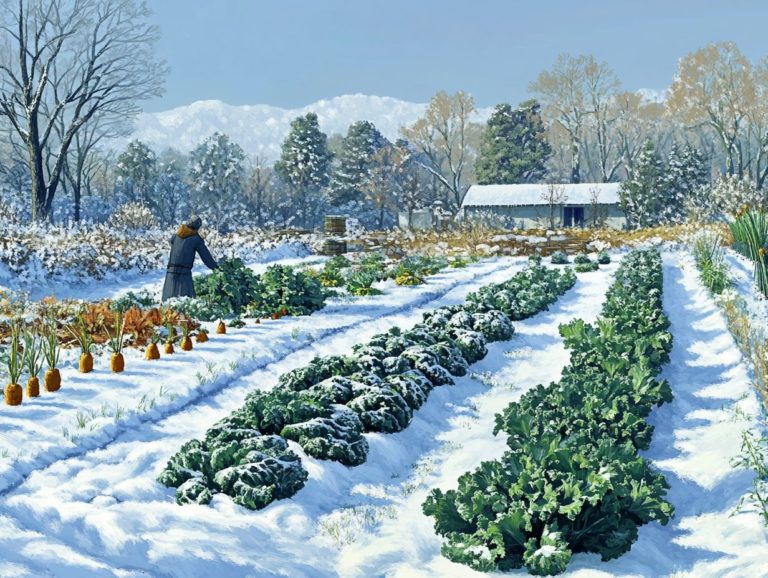Winter Composting: Tips for Cold Climates
Composting in winter may sound challenging, but it offers unique benefits that can enhance your gardening all year round.
Let s explore why winter composting is worthwhile and how you can confidently prepare for it.
Familiarize yourself with effective composting methods. You ll learn to manage temperature in cold conditions and tackle challenges like freezing and moisture control.
Harvesting your winter compost is essential! Use it to enrich your soil, setting the stage for thriving plants.
Embrace winter composting to transform your gardening approach!
Contents
- Key Takeaways:
- Why Compost in Winter?
- Preparing for Winter Composting
- Composting in Cold Temperatures
- Common Challenges and Solutions
- Harvesting and Using Winter Compost
- Frequently Asked Questions
- What is winter composting and why is it important in cold climates?
- How does winter composting differ from traditional composting methods?
- What are some tips for successful winter composting?
- Can I continue to add kitchen scraps to my compost pile during the winter?
- Can I use the compost produced during the winter?
- Are there specific materials I should avoid composting during the winter?
Key Takeaways:

- Winter composting has numerous benefits, such as reducing waste and providing nutrient-rich soil for spring planting.
- Proper preparation, including selecting the right compost bin and storing materials, is crucial for successful winter composting.
- Insulating and covering your compost pile helps maintain temperature, while managing moisture levels prevents freezing and thawing.
Why Compost in Winter?
Composting during winter might feel counterintuitive, yet it presents a wealth of benefits that enhance both the decomposition process and the health of your garden.
In colder climates like Ontario, Canada, winter composting allows food scraps and yard waste to break down gradually, enriching the soil with essential nutrients just in time for spring.
It also helps in managing food waste effectively, transforming it into compost that you can utilize for gardening and landscaping projects.
By embracing winter composting, you bolster your compost maintenance efforts, ensuring that your goals remain on track, even when temperatures drop.
Benefits of Winter Composting
Winter composting presents a remarkable opportunity that enhances decomposition and elevates the quality of your compost and the health of your garden during the chilly months.
As food scraps accumulate in your kitchen, seize the moment to repurpose waste effectively. By layering materials like kitchen scraps, dried leaves, and straw, you create an ideal balance of green (nitrogen-rich) and brown (carbon-rich) materials.
This balance not only insulates your compost pile but also retains valuable heat.
Even in the depths of winter, microorganisms remain active, albeit at a slower pace. Keeping the pile well-aerated (having air flow through it) and moist significantly boosts their efficiency.
Utilizing sturdy compost bins that trap warmth and employing a thermal cover ensures that microbial activity continues, leading to faster decomposition.
As a result, when spring arrives, your compost will enrich the soil, suppress weeds, and improve moisture retention, making it a critical asset for winter garden maintenance.
Preparing for Winter Composting
Get ready for winter composting with some smart planning and effective methods to ensure the successful decomposition of kitchen waste, yard scraps, and other compostable materials in the colder months.
Choosing the right compost bin or tumbler is essential; this decision can significantly speed up the process by promoting better aeration and maintaining optimal temperatures.
Furthermore, integrating a balanced mix of nitrogen-rich greens (like vegetable scraps) and carbon-rich browns (like dried leaves) will elevate your composting efforts, setting the stage for efficient and productive winter composting.
Choosing the Right Composting Method
Choosing the right composting method is crucial for effective winter composting, especially in cold climates where frozen kitchen scraps and food waste can present challenges.
To navigate these hurdles, you can utilize a variety of methods, such as compost bins that retain heat or compost tumblers that enhance aeration. Each option provides distinct advantages, enabling decomposition even in frigid temperatures.
Managing frozen scraps is essential. Employing techniques like layering with dry leaves can significantly promote breakdown. It s also important to use animal-proof containers to keep unwanted visitors like raccoons and coyotes at bay, ensuring the integrity of your composting process remains intact.
By selecting the right tools and techniques, you can make winter composting both efficient and eco-friendly.
Collecting and Storing Materials

Collecting and storing materials for winter composting is an essential step in ensuring you have a steady supply of compostable items, like food scraps and yard debris, even when the temperatures drop.
To streamline this process, it’s wise to think ahead about the types of materials that will contribute to a well-balanced compost pile. Many people underestimate the importance of maintaining moisture levels, especially during winter when everything tends to dry out.
One effective strategy is to designate a kitchen waste container that seals tightly, keeping odors at bay while trapping moisture. For yard scraps, consider using a compost bin that s insulated to shield against freezing temperatures.
Regularly mixing these materials not only aerates the compost, or allows air to reach it, but also boosts microbial activity. This ensures that composting keeps on rolling, even in the colder months.
Composting in Cold Temperatures
Composting in cold temperatures poses distinct challenges that demand tailored strategies to ensure effective compost turnover and a rise in temperature both crucial for achieving optimal decomposition. By understanding these nuances, you can navigate the intricacies of cold-weather composting with confidence.
Strategies for Maintaining Temperature
Maintaining the right temperature in your compost pile during winter is essential for creating the ideal conditions for decomposition. This ensures that your compost materials break down effectively.
As the chill of winter sets in, implement various strategies to retain heat and moisture within your pile. Insulating your compost bins with materials like straw bales or old blankets can significantly minimize heat loss.
Layering different compost materials helps create a balanced environment that encourages microbial activity. Mix green materials like vegetable scraps, which are high in nitrogen, with brown materials like dried leaves, which are high in carbon.
Employ compost aeration techniques, such as regularly turning the pile or using aeration tubes. These methods help maintain airflow, which is vital for sustaining an ideal temperature despite the cold. Together, they keep your compost process active and productive, ensuring your efforts yield rich, nourishing results come spring.
Common Challenges and Solutions
Winter composting comes with its own set of challenges, but you can tackle them effectively! You may find yourself managing frozen scraps, ensuring that moisture levels remain adequate, and addressing the specific requirements for compost recovery in colder climates.
Addressing Freezing and Thawing
Addressing freezing and thawing cycles is crucial for effective compost management during winter. These processes can significantly affect both compost volume and the decomposition process.
When temperatures drop, the moisture within your compost pile may freeze, leading to changes in texture and thermal dynamics. As the pile thaws, it might form clumps that disrupt airflow, ultimately slowing down the microbial activity essential for decomposition.
To maintain the integrity of your compost, periodically break apart the thawed chunks and incorporate air. This promotes an even distribution of temperature and moisture. Regularly monitor the conditions of your compost such as temperature and moisture levels to help you tackle any issues before they escalate.
Utilizing a thermometer and moisture meter will provide you with valuable insights into the health of your compost, allowing for timely interventions during these cycles.
Managing Moisture Levels

Managing moisture levels during winter composting is crucial for maintaining optimal conditions and ensuring effective breaking down of your compost materials.
Without the right moisture, the process can significantly slow down. This results in a less efficient composting system.
To gauge moisture content, try a simple squeeze test: if you can form a ball with a handful of compost without any water dripping, you’re likely in the sweet spot.
If the compost feels on the dry side, add water in small increments. This will help you achieve the desired consistency.
You can also include moisture-retaining materials like straw or shredded leaves. These can enhance the overall health of your compost, allowing it to hold onto that precious moisture even in chilly temperatures.
By utilizing these composting insights, you can ensure that your compost remains active and nutrient-rich throughout the winter months.
Harvesting and Using Winter Compost
Harvesting and utilizing winter compost effectively can greatly enhance your garden s vitality. It also improves overall soil health.
By doing so, you re ensuring that essential nutrients are readily available for your plants as they emerge in the spring.
Tips for Successful Harvesting
Successful harvesting of winter compost hinges on specific techniques. These ensure the compost is fully finished and poised to deliver maximum benefits to your garden.
To gauge readiness, look for visual cues like a dark, crumbly texture. It should also have a smell reminiscent of fresh earth, steering clear of any sharp or unpleasant odors.
Maintaining a consistent moisture level is essential. If your compost feels overly dry or too soggy, you might need to make some adjustments.
Timing is critical aim to harvest in the spring as temperatures begin to rise. This creates an ideal environment for beneficial microbes to flourish.
Techniques such as turning the compost prior to harvesting can aerate it. This enhances the decomposition process and leads to a nutrient-rich end product.
Keep a close eye on these signs to unleash the full power of your winter compost!
Ways to Use Winter Compost
Using winter compost in your garden can significantly enhance soil structure and provide essential nutrients. It also improves overall plant health.
By incorporating this organic matter into your garden beds, you create a rich environment that fosters robust growth.
It s an excellent amendment for your potted plants, offering a balanced mix of nutrients that encourages thriving indoor greenery.
For your landscaping projects, applying winter compost can lead to healthier lawns, vibrant flower beds, and more resilient shrubs.
Its ability to retain moisture while improving drainage makes it particularly beneficial across various compost methods. This includes traditional piles, tumblers, or worm bins.
With a mindful approach, you can easily harness its numerous benefits to elevate your gardening experience.
Frequently Asked Questions
What is winter composting and why is it important in cold climates?

Winter composting is the practice of composting during the colder months in regions with low temperatures. It’s important in cold climates because it allows for the continuation of nutrient-rich compost production, even when traditional outdoor composting may not be possible.
How does winter composting differ from traditional composting methods?
Winter composting typically involves advanced techniques such as insulated compost bins or indoor composting systems. These methods maintain the optimal temperature needed for the composting process, despite the colder weather.
What are some tips for successful winter composting?
Some tips for successful winter composting include using a compost thermometer to monitor temperature. Also, use smaller compost materials to speed up the breaking down process, and keep the compost bin properly insulated.
Start your winter compost journey today for a healthier garden tomorrow!
Can I continue to add kitchen scraps to my compost pile during the winter?
Yes, you can keep adding kitchen scraps to your compost pile during winter. Just push the scraps deeper to stop them from freezing on top.
Can I use the compost produced during the winter?
Yes, winter compost is usable. Cold temperatures can slow down decomposition, but your compost will still be rich in nutrients for your plants.
Are there specific materials I should avoid composting during the winter?
Avoid large and bulky materials like branches or twigs they won’t break down easily in the cold. Also, steer clear of adding animal products or fats to your compost pile now.






